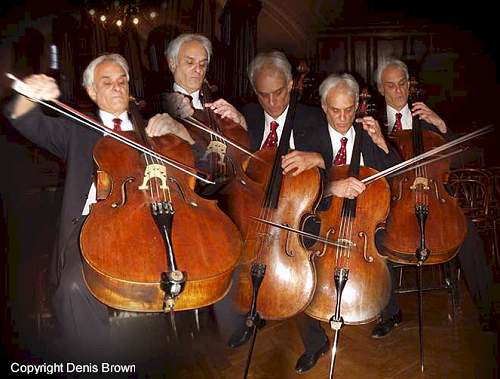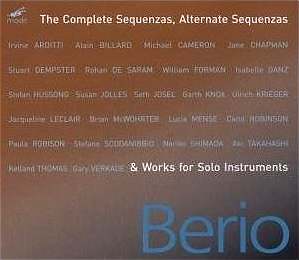Rohan de Saram on Berio and new
musical horizons.
by Anne Ozorio

Since the age of 11,
when he came to Italy to study with
Gaspar Cassado, Rohan de Saram has moved
in the most interesting musical circles.
He studied with John Barbirolli and
Pablo Casals. Dimitri Mitropoulos called
him "a rare genius, a born musician".
Heís worked with many of the
interesting composers of our time, among
them Poulenc, Kodaly, Shostakovich,
Berio, Xenakis and Elliot Carter. Yet
he remains a natural, unassuming person.
Once he starts to talk about music,
though, his face lights up with enthusiasm.
His love for the violoncello literally
shines through, animating his conversation.
 His
long awaited recording of Berioís Sequenza
XIV is at last available. Itís marvellous
and is a milestone in the repertoire.
When Berioís Il Ritorno Degli Snovidenia,
for cello and orchestra was given its
UK première by Rohan, a tape
of the performance was sent to the composer.
In reply, Rohan received a very appreciative
letter from Maestro Berio where, among
other things, he wrote, "Your performance
of Ritorno is splendid, but
besides Ritorno, your sound,
your perfect intonation, your phrasing
and bowing technique, make you a great
performer of any music." They met for
the first time in Florence in the 1990s.
De Saram played the transcription of
Sequenza VI for viola, which he had
made for personal study as he was particularly
interested in contemporary writing for
solo stringed instruments. Afterwards,
Berio asked him to send it to his publishers,
Universal Edition in Vienna. Later,
it was included in the major Brussels
performance of the complete Sequenze
written up to that time, in the composers
presence, for there was as yet no Sequenza
specifically for cello. During these
years Rohan also had the opportunity
of giving further performances of Il
Ritorno Degli Snovidenia, with Berio
himself conducting, in various European
cities including London, where it was
played at the Barbican Centre.
His
long awaited recording of Berioís Sequenza
XIV is at last available. Itís marvellous
and is a milestone in the repertoire.
When Berioís Il Ritorno Degli Snovidenia,
for cello and orchestra was given its
UK première by Rohan, a tape
of the performance was sent to the composer.
In reply, Rohan received a very appreciative
letter from Maestro Berio where, among
other things, he wrote, "Your performance
of Ritorno is splendid, but
besides Ritorno, your sound,
your perfect intonation, your phrasing
and bowing technique, make you a great
performer of any music." They met for
the first time in Florence in the 1990s.
De Saram played the transcription of
Sequenza VI for viola, which he had
made for personal study as he was particularly
interested in contemporary writing for
solo stringed instruments. Afterwards,
Berio asked him to send it to his publishers,
Universal Edition in Vienna. Later,
it was included in the major Brussels
performance of the complete Sequenze
written up to that time, in the composers
presence, for there was as yet no Sequenza
specifically for cello. During these
years Rohan also had the opportunity
of giving further performances of Il
Ritorno Degli Snovidenia, with Berio
himself conducting, in various European
cities including London, where it was
played at the Barbican Centre.
Berio was fascinated
by folk instruments from other cultures,
so when developing the cello Sequenza,
he asked about music from Sri Lanka,
where de Saram grew up. "I have
played the Kandyan drum from Sri Lanka
since I was a boy. He asked me to send
him some recordings of some of the Kandyan
drum rhythms, which I did, along with
my written notations which would clarify
the intricacies of the rhythms",
he says. "Some years later, Sequenza
XIV was completed, two sections of this
piece using some of the drum rhythms
from the collection I had sent him.
This was realised in a unique way where
the cellistís right hand, playing without
the bow, taps the rhythms on the body
of the cello while the left hand synchronously
plays percussively on the strings. In
these two sections, intervals of a tritone
are prominent in the left hand percussion
on the strings. The main bulk of the
Sequenza uses the cello in its unrivalled
capacity as a lyrical singing instrument,
with almost vocal flexibility and range
of expression. These long melodic lines
use a very wide range of constantly
changing dynamics and timbre, interspersed
with "Bartok pizzicato" and
very ornamental passages. Towards the
end of the piece, a two-note "glissando"
figure, to be played ffff, "violente
& aggressive", alternates
with very distant notes sounding ppp.
Although different in character from
the violin and viola Sequenze with their
more obviously "virtuosic"
natures, the cello Sequenza is nevertheless
very demanding on the imaginative perception
and virtuosity of the performer in the
widest sense."
Having played more
new music for his instrument than perhaps
any other cellist, together with a wide
range of classical repertoire, hearing
him make links and connections is fascinating.
For example, he compares
Sequenza XIV with Brittenís Third
Suite for solo cello, which he has
also recorded along with Suites no.
1 and 2. "In both cases the composers
use folklore from the countries of the
dedicatees, Russia in the case of Britten
and Sri Lanka in the case of Berio.
The former, which is dedicated to Rostropovich,
uses melodic material as a basis for
the whole Suite whereas the Sri Lankan
drum rhythm material is used by Berio
as a contrast to the melodic writing
in the rest of his "Sequenza".
It is also significant that both these
works were written at the end of the
composersí lives. In Brittenís case,
his quotations from the "Kontakion",
the chant for the dead from the Russian
Orthodox service, make his thoughts
explicit."
In addition to encouraging
composers both eastern and western to
write for solo cello and for duos and
chamber works for cello with a variety
of other instruments, Rohan is convinced
of the great importance of improvisation.
As composers like Berio found, non-notational
music, improvisation and music from
non-western cultures can fertilise new
ideas. Since leaving the Arditti Quartet
at the end of November 2005 in order
to pursue his own artistic vision, Rohan
has been working with a wide range of
artists and composers from around the
globe, including in his programmes both
classical and contemporary repertoire
as well as improvisations. Itís a courageous,
imaginative direction for de Saram,
a man with a truly artistic soul.
Rohan de Saramís website: www.rohandesaram.co.uk
Review
of Berio Sequenzas

